1. Princess Juliana Airport (Saint Martin) – Planes Fly Just Feet Over a Public Beach Where Tourists Gather

On the Caribbean island of Saint Martin, Princess Juliana International Airport offers one of the world’s most thrilling airport experiences. The runway begins only about 100 feet from Maho Beach, a vibrant stretch of sand where tourists gather not just to sunbathe but to watch planes approach at breathtakingly low altitudes. Jets like the Boeing 737 or Airbus A320 descend to land just a few dozen feet above the beachgoers, with engines roaring and exhaust blasts strong enough to send sand flying and hair whipping. This surreal proximity has made it a mecca for plane spotters and adrenaline junkies, creating a unique blend of tropical vacation and high-octane spectacle.
Originally built during World War II by the U.S. military as a refueling base, the airport was later named for Princess Juliana of the Netherlands and has grown into a vital Caribbean transport hub, handling more than 1.3 million passengers each year. Despite numerous warning signs and barriers designed to keep spectators safe, Maho Beach remains the iconic spot to experience these low-altitude approaches up close. The airport’s 7,546-foot runway and seaside location present constant challenges to pilots, who require precision flying skills to navigate the final approach while contending with shifting weather and strong trade winds. For visitors, the thrill of standing under a landing jet remains an unforgettable highlight of any trip to Saint Martin.
2. Barra Airport (Scotland) – The Only Airport in the World Where Scheduled Flights Land Directly on Sand
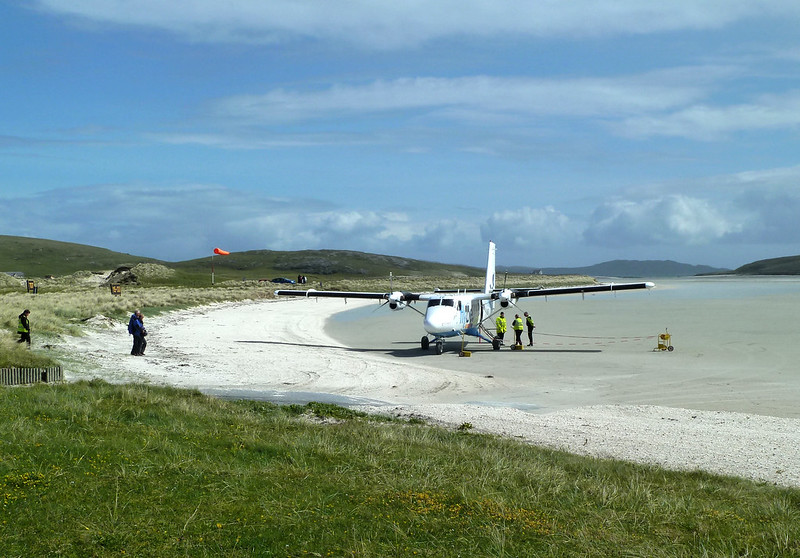
Barra Airport is an extraordinary anomaly in the aviation world, located on the Outer Hebrides, a rugged island chain off Scotland’s west coast. What makes it truly unique is its runway — not asphalt or concrete, but a vast sandy beach called Traigh Mhòr that doubles as a landing strip during low tide. Scheduled flights land and take off directly on the sand, turning the tide into a natural runway scheduler. Pilots must carefully consult tidal charts and plan flights around the twice-daily high tides that flood the runways, forcing the airport to operate on nature’s unpredictable timetable. With no permanent runway infrastructure, the airport uses simple markers to guide aircraft safely onto the sand, creating a rare aviation experience that blends seamlessly with the environment.
Opened in 1936, Barra Airport has served as a crucial connection point for island residents, offering essential access to mainland Scotland and beyond. The airfield typically accommodates small, rugged aircraft like the Britten-Norman Islander, capable of handling the variable beach conditions. The airport’s very existence depends on a delicate balance between human technology and the natural world — sand, sea, and sky all play roles in the operation. For travelers, landing here is a thrilling reminder of how aviation can adapt to the wildest landscapes. Beyond its functional importance, Barra’s sandy runway has become a bucket-list destination for aviation fans eager to witness or experience the rarest of runway environments.
3. Gibraltar Airport (Gibraltar) – A Busy Highway Runs Straight Across the Runway
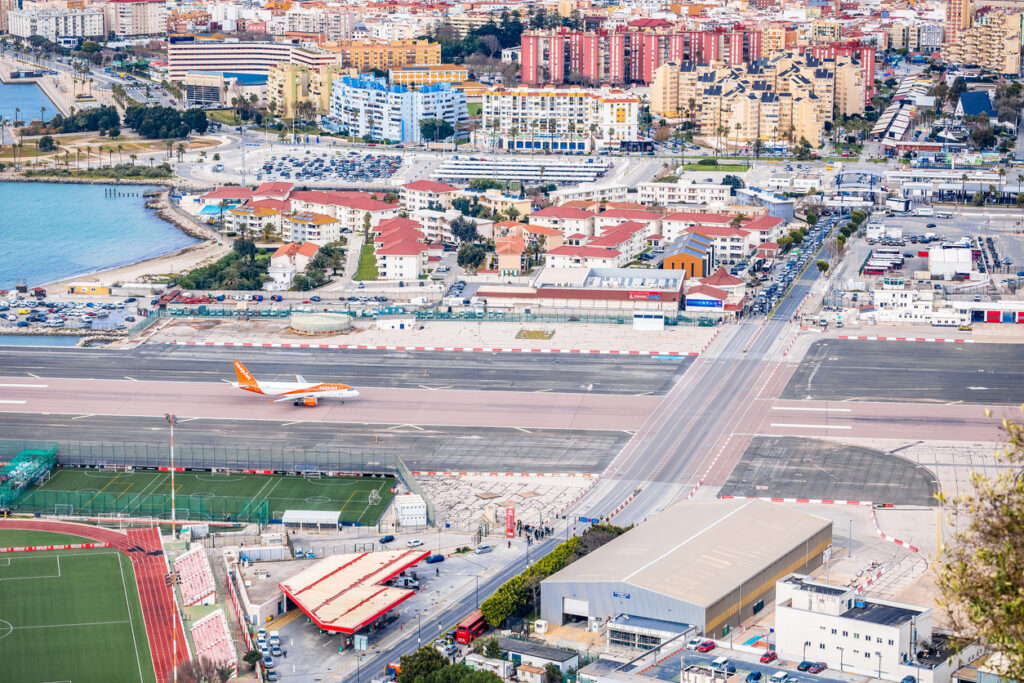
Gibraltar Airport is a rare marvel where aviation and daily life collide in the most literal sense. Situated on the tiny British Overseas Territory at the southern tip of the Iberian Peninsula, this airport’s runway famously cuts right through Winston Churchill Avenue, Gibraltar’s main road. Every time a plane prepares to land or take off, traffic is halted by barriers similar to railroad crossings, turning the busy street into a temporary no-go zone. This extraordinary setup stems from Gibraltar’s extreme land constraints surrounded by the sea and the imposing Rock of Gibraltar, space is so limited that a conventional airport design was impossible. It’s one of the only airports worldwide where cars and jets literally share the same space, creating a surreal intersection of air and ground traffic.
Despite its unusual layout, Gibraltar Airport handles about 1.3 million passengers annually, mostly connecting to London, the Canary Islands, and other European destinations. The runway is 5,827 feet long, enough for medium-sized aircraft but challenging for larger jets. Pilots must carefully time takeoffs and landings, while ground controllers coordinate with road traffic to ensure safety. The presence of the highway has even led to creative airport rules—pedestrians crossing the runway must follow strict signals, and vehicles line up as if waiting at a railway crossing. This extraordinary blend of urban hustle and aviation precision highlights Gibraltar’s ingenuity in maximizing every inch of limited territory.
4. Kansai International Airport (Japan) – Built on a Man-Made Island Prone to Sinking and Typhoons
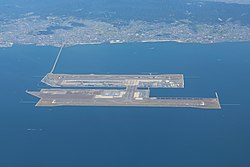
Kansai International Airport is an engineering marvel perched on an artificial island in Osaka Bay, designed to relieve overcrowding at Osaka’s original airport and serve the Kansai region, including Kyoto and Kobe. Constructed between 1987 and 1994 at a staggering cost exceeding $15 billion, the airport rests on a 3.75-square-mile (9.5 square kilometers) man-made island created by reclaiming land from the sea. Despite cutting-edge engineering, the island has experienced significant sinking — reportedly up to 30 feet since construction — requiring continuous adjustment of the runway and terminal structures. This relentless subsidence is compounded by the region’s frequent typhoons and seismic activity, making Kansai a triumph of human ingenuity against nature’s forces.
The airport features two parallel runways and a terminal capable of handling over 28 million passengers annually. It ranks among the busiest in Japan, acting as a critical international hub. Its location on an artificial island was chosen to minimize noise pollution and free up urban space, but the airport’s isolation means every utility, from water to electricity, must be supplied via underwater tunnels. Despite these challenges, Kansai has won awards for its design and resilience, with advanced drainage systems and storm-resistant structures to withstand typhoon impacts. Its dramatic setting, surrounded by water on all sides, makes arrivals and departures breathtaking moments of contrast between the engineered environment and the vast Pacific Ocean.
5. Courchevel Altiport (France) – Steeply Sloped Runway Used Only by Specially Certified Pilots

High in the French Alps, Courchevel Altiport is more of a pilot’s ultimate test than a typical airport. Located at 6,588 feet (2,008 meters) above sea level, its runway measures just 1,700 feet (518 meters) and has a steep slope of 18.5 percent. This uphill incline helps planes slow down quickly during landing, but it requires exceptional skill from pilots, both for landing and takeoff. The airport primarily serves the upscale ski resort of Courchevel, welcoming small planes and helicopters during winter months when mountain roads become dangerous or closed.
Due to its challenging conditions, narrow runway, mountainous terrain, rapidly shifting weather, and high altitude, only pilots with special certification from French aviation authorities are permitted to fly here. Approaching the altiport means navigating tight alpine valleys while contending with unpredictable winds and snow-covered landscapes. Perched on a cliff, the runway offers breathtaking views but demands absolute precision. Courchevel is widely known as one of the most difficult airports to operate in, perfectly reflecting the blend of geographic challenge and the adventurous spirit of Europe’s premier winter destination.
6. Don Mueang International Airport (Thailand) – Features a Full Golf Course Between Runways
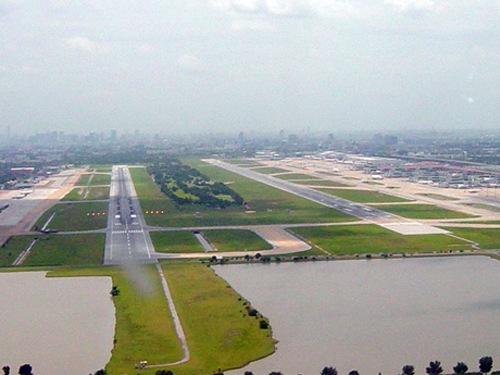
Don Mueang International Airport in Bangkok is a fascinating blend of a busy aviation hub and an unexpected leisure oasis. Established in 1914, it is one of the world’s oldest international airports and remains a key gateway for low-cost carriers and domestic flights in Thailand. What makes it truly unique is the full-sized golf course nestled between its two parallel runways. Known as Kantarat Golf Course, this lush green expanse offers a striking contrast to the constant hum of planes taxiing, taking off, and landing just meters away. Golfers tee off amid the backdrop of soaring aircraft, an unusual coexistence of sport and travel rarely seen elsewhere.
The airport handles over 40 million passengers annually, striking a balance between its historic charm and modern functionality. Despite being overshadowed by the newer Suvarnabhumi Airport, Don Mueang plays a vital role in Thailand’s aviation network. The golf course itself is meticulously maintained, and the proximity to active runways requires careful coordination between air traffic control and course management to ensure safety for both golfers and pilots. This rare feature adds a layer of calm and greenery to an otherwise bustling airport environment, showcasing Thailand’s unique ability to blend tradition, leisure, and modern infrastructure.
7. Juancho E. Yrausquin Airport (Saba) – Just 1,300 Feet Long, It’s One of the Shortest Commercial Runways
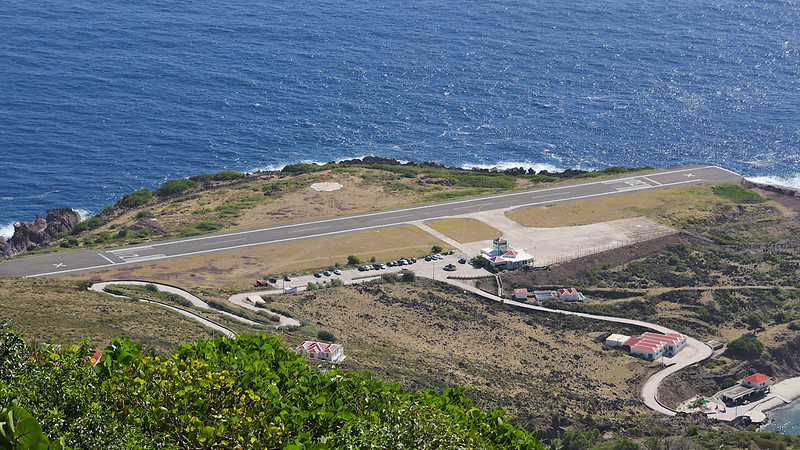
On the tiny Caribbean island of Saba, Juancho E. Yrausquin Airport holds the distinction of having one of the world’s shortest commercial runways at a mere 1,312 feet (400 meters) in length. This extremely limited runway length makes landings and takeoffs a heart-stopping experience, leaving almost no room for error. The airport sits perched on cliffs with steep drops into the sea at both ends, adding to the intensity for pilots and passengers alike. Due to these challenging conditions, only specially trained pilots with permits are authorized to operate flights here, typically flying small turboprop planes such as the DHC-6 Twin Otter.
The airport is a crucial lifeline for Saba’s roughly 1,900 residents, providing essential connections to the neighboring islands and beyond. Constructed in the 1960s, it has earned a reputation as one of the most dangerous airports in the world, attracting adventurous travelers who seek both beauty and a thrill. The breathtaking scenery combined with the runway’s precarious location makes every flight feel like an adventure. Despite its challenges, Juancho E. Yrausquin remains vital for tourism, medical evacuations, and supplies, proving that even the shortest runway can hold immense importance.
8. Ice Runway (Antarctica) – Planes Land on Compacted Ice with No Permanent Structures

In the vast, frozen expanse of Antarctica, some runways are made entirely of compacted ice and snow, offering a surreal and extreme landing experience unlike any other on Earth. These ice runways are temporary, created each season on frozen lakes or sea ice to support scientific research stations scattered across the continent. Without permanent paved surfaces or terminals, pilots navigate open expanses of ice marked by simple flags or markers, relying heavily on favorable weather and meticulous timing. Specialized grooming machines must continuously maintain the runway surfaces to ensure they remain firm and smooth enough for safe landings and takeoffs.
Serving as critical lifelines for Antarctica’s research community, ice runways facilitate the delivery of essential supplies, personnel, and scientific equipment during the relatively mild summer months. The challenging conditions include extreme cold, strong winds, and unpredictable weather shifts that can halt flights with little warning. Many planes operating here are specially modified to handle icy surfaces and frigid temperatures. The absence of permanent structures means crews often work in temporary shelters and tents. These ice runways stand as testaments to human ingenuity and adaptability, enabling exploration and discovery in one of the harshest environments on the planet.
9. Agatti Airport (India) – A Narrow Strip with Sea Cliffs on Both Ends, Connecting Remote Islands
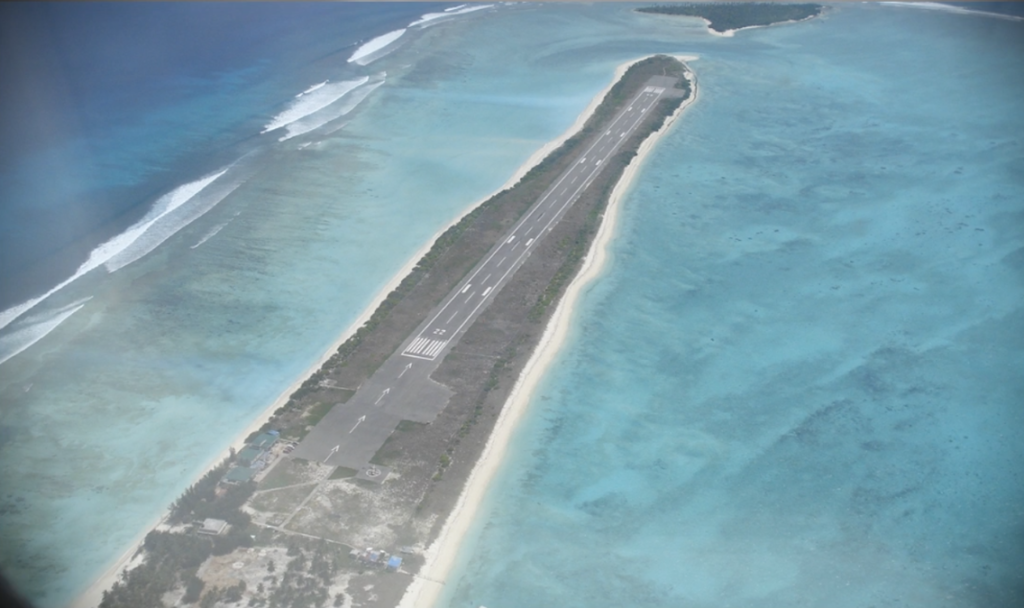
Agatti Airport serves as the gateway to India’s remote Lakshadweep Islands, located in the Arabian Sea nearly 300 kilometers off the southwest coast of the mainland. The airport’s runway is an exceptionally narrow strip of just about 3,300 feet (1,000 meters), squeezed tightly between the turquoise waters and steep sea cliffs at both ends. This precarious positioning demands high precision from pilots during landings and takeoffs, with little margin for error. The airstrip connects Agatti Island to other islands in the archipelago as well as to the Indian mainland, providing essential transport for locals and tourists alike.
Built on a coral atoll, the airport’s limited space reflects the delicate ecosystem surrounding it. Weather can change rapidly, and crosswinds from the sea challenge pilots further, adding to the runway’s reputation as a demanding airfield. Despite its small size and remote location, Agatti Airport plays a vital role in emergency medical evacuations, tourism, and supply runs, connecting these isolated islands to the wider world. Its scenic approach over crystal-clear waters makes it a breathtaking experience for passengers, even as the geographical constraints create operational complexities for the airport.
10. Madeira Airport (Portugal) – Built Partly on Stilts Due to Its Cliffside Coastal Location
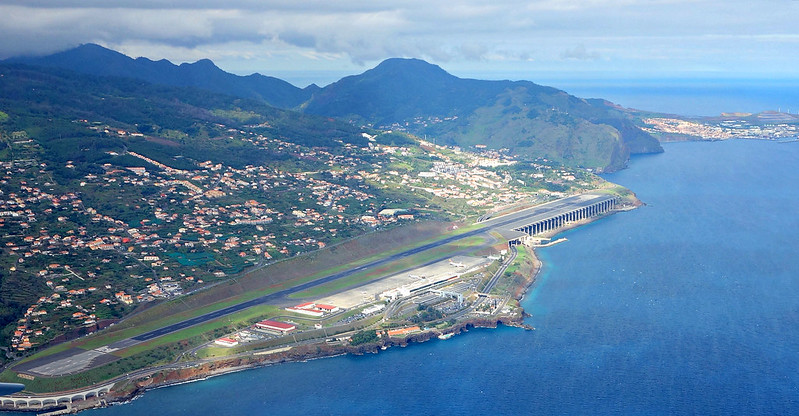
Madeira Airport, officially known as Cristiano Ronaldo International Airport, is an engineering marvel perched on the rugged cliffs of Portugal’s Atlantic island. Due to limited flat land on the volcanic island, a significant portion of its 6,076-foot (1,852-meter) runway is supported by a complex network of more than 1,000 concrete stilts rising up to 230 feet (70 meters) above the ocean below. This elevated design was necessary to extend the runway safely over uneven terrain and deep coastal waters, allowing the airport to accommodate larger aircraft and increasing passenger capacity. The airport serves over 3 million travelers annually, acting as the main air gateway to this popular island destination.
Pilots face one of the most challenging approaches in the world when landing here, as strong crosswinds and sudden weather shifts are common in the region. The runway’s partial over-water construction, combined with the surrounding steep cliffs, creates dramatic visuals but demands precision flying. Madeira’s runway expansion project, completed in 2000, is often cited as a textbook example of balancing ambitious engineering with environmental sensitivity. This unique structure not only makes the airport safer and more functional but also stands as a testament to human ingenuity in overcoming geographical obstacles.
11. Paro Airport (Bhutan) – Surrounded by Himalayan Peaks, Only a Few Pilots Are Licensed to Land There
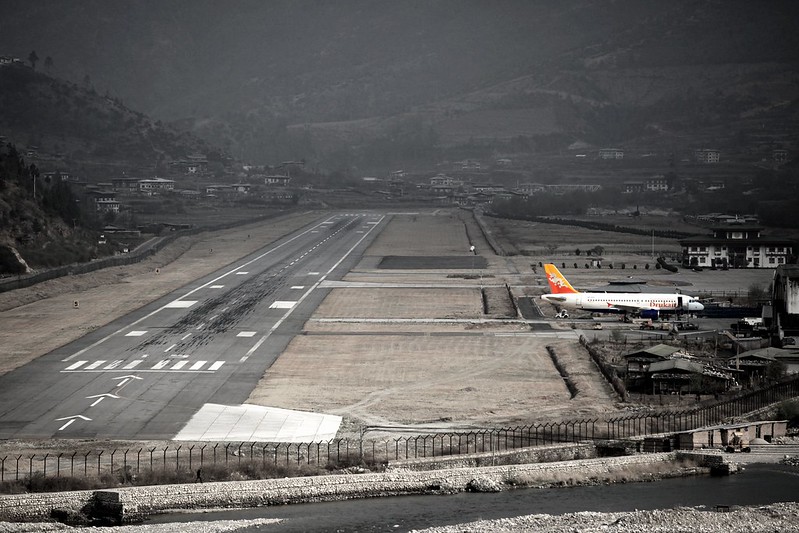
Paro Airport, nestled in a deep valley at 7,332 feet (2,235 meters) above sea level, is famously one of the most challenging airports for pilots worldwide. Surrounded by Himalayan peaks soaring up to 18,000 feet (5,500 meters), the airport’s approach requires pilots to navigate tight mountain passes and make steep, precise turns just moments before landing. Due to these extreme conditions, only about eight pilots worldwide have the certification needed to land at Paro, each undergoing rigorous training to master the high-altitude, terrain-challenging approach. This airport is Bhutan’s sole international gateway, making it a critical access point for visitors to the Himalayan kingdom.
The runway itself is 6,562 feet (2,000 meters) long and sits in a valley that limits maneuvering room. Weather can change rapidly, with fog and strong winds adding to the difficulty. Despite these hazards, Paro Airport handles commercial flights from airlines such as Druk Air and Bhutan Airlines, connecting Bhutan to cities like Kathmandu, Delhi, and Bangkok. The experience of flying into Paro is often described as breathtaking and nerve-wracking, offering travelers stunning panoramic views of the Himalayas while underscoring the extraordinary skill required of the pilots who bring them safely to the ground.
12. Lukla Airport (Nepal) – The Gateway to Everest with a Dangerously Short Uphill Runway
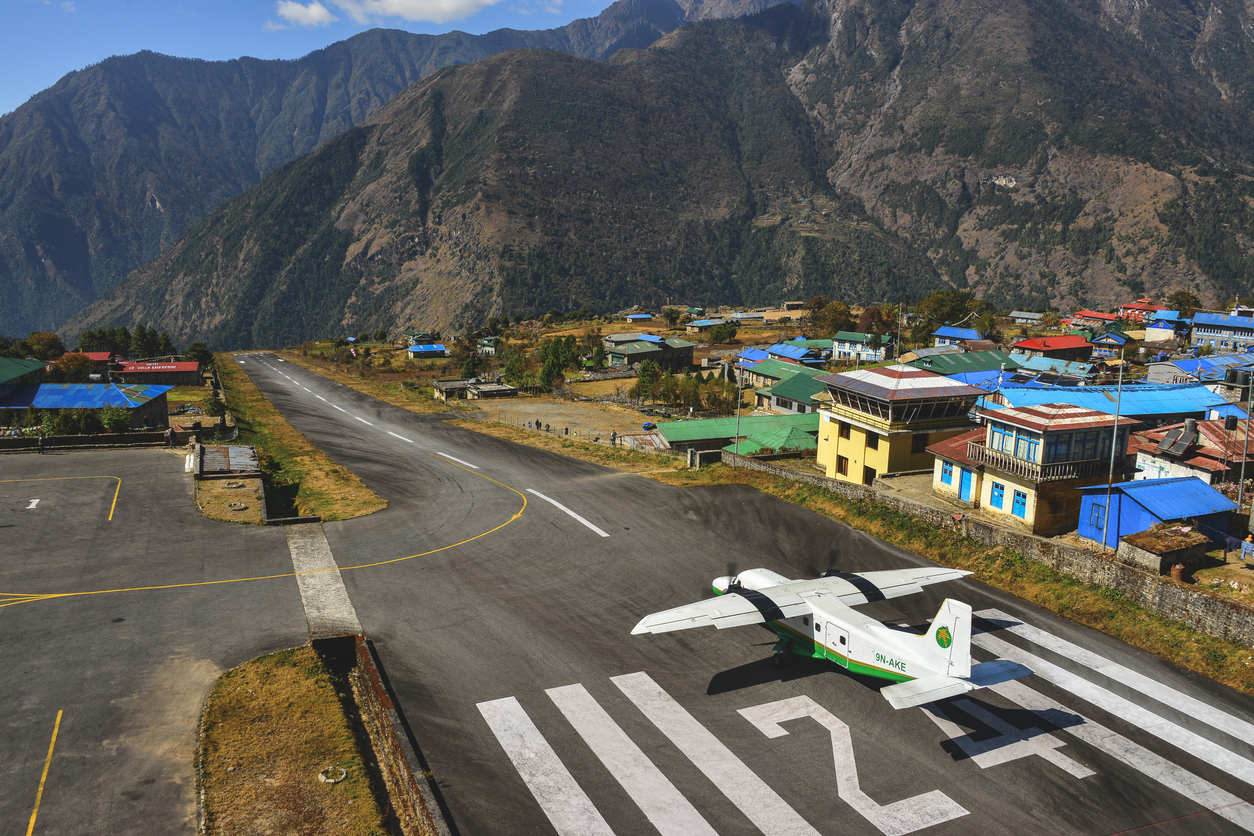
Lukla Airport, perched at an elevation of 9,334 feet (2,845 meters), is widely known as the gateway for trekkers heading to Mount Everest. Its runway is notoriously short, only about 1,729 feet (527 meters), and it slopes sharply uphill at roughly a 12 percent gradient. This steep incline helps aircraft decelerate on landing but requires pilots to be exceptionally skilled to navigate the brief runway and the unpredictable mountain winds. Located in a deep Himalayan valley, the airport’s approach is surrounded by towering peaks and deep ravines, giving pilots very little room for error and making Lukla one of the world’s most dangerous airports.
Despite the risks, Lukla Airport is the lifeline for the remote Khumbu region, handling dozens of flights daily during the busy trekking season. It primarily serves small STOL (short takeoff and landing) aircraft, such as the DHC-6 Twin Otter, which can handle challenging conditions. Weather delays are common, as fog, wind, and snow can quickly close the airstrip. Besides tourism, the airport is critical for delivering supplies and supporting medical evacuations in this rugged region. For travelers, the exhilaration of landing at Lukla marks the start of an epic Himalayan adventure, highlighting the extraordinary skill of the pilots who operate in such extreme environments.
The story 12 Airports So Strange You Won’t Believe They’re Real (But They Are) was first published on DailyFetch.


